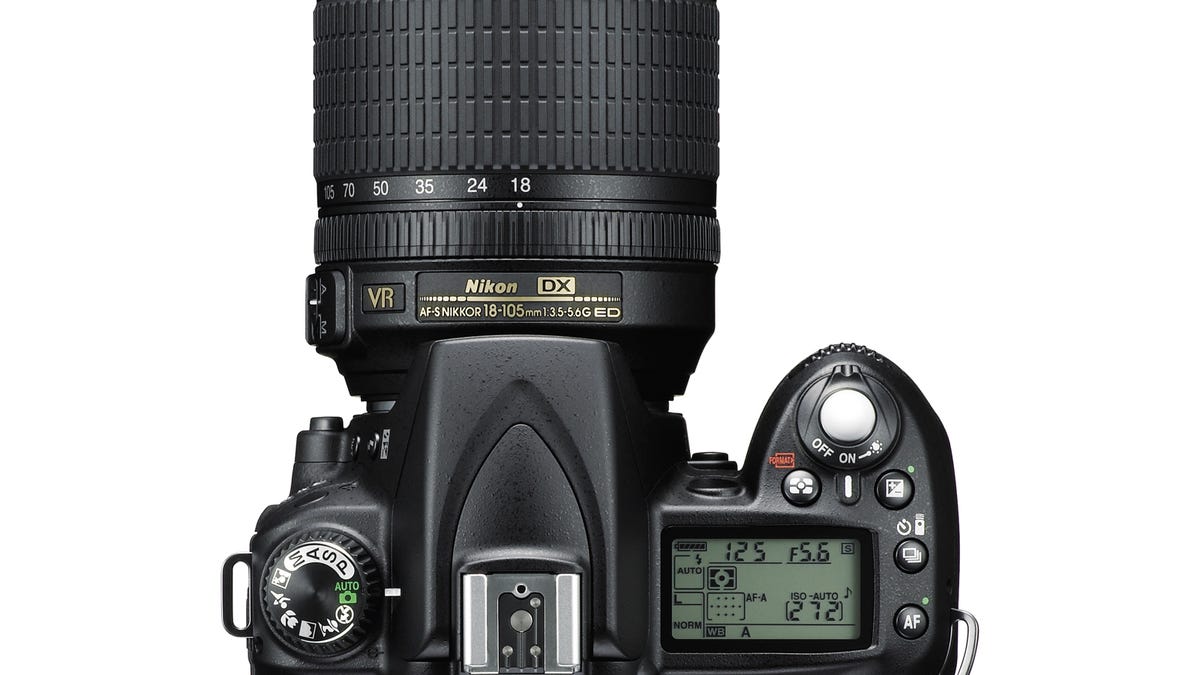Nikon D90 at long last: First dSLR to do video
A bump to 12 megapixels and faster shooting add to the camera's enhancements over the D80.

The much-rumored and even more longed-for update to the
Though its movie-capture specs aren't too shabby--24fps 1280x720 motion JPEG and support for VR optical image-stabilization if the lens has it--D-Movie still doesn't match the best of the snapshot-camera movie modes.
For instance, exposure is fixed for the length of the clip, it has monaural sound, and you can only focus manually while shooting. HD clips are capped at five minutes, likely to keep the sensor from overheating since movie capture operates in Live View mode. Still, this has been a long-awaited feature in the entry-level segment, since it's one of the two important most features users have had to sacrifice when moving up to dSLRs (the other being pocketability).
Though some early rumors got all hot and bothered about GPS in this model, it's not built in. Nikon has also announced the GP-1 hotshoe GPS unit for its entire dSLR line, and the D90 includes the appropriate socket for the 10-pin cable.
With the
| D80 | D90 | 40D | |
| Sensor | 10.2-megapixel CMOS | 12.3-megapixel CMOS | 10.1-megapixel CMOS |
| A/D conversion | 12-bit | 12-bit | 14-bit |
| Sensitivity range | ISO 100 - ISO 3200 (Hi1) | ISO 100 - ISO 6400 (Hi1) | ISO 100 - ISO 3200 (expanded) |
| Focal-length multiplier | 1.5x | 1.5x | 1.6x |
| Continuous shooting | 3 fps 23 JPEG/6 raw | 4.5 fps n/a | 6.5fps 75 JPEG/17 raw |
| Viewfinder | 95% coverage 0.94x magnification fixed focusing screen | 96% coverage 0.94x magnification fixed focusing screen | 95% coverage 0.95x magnification interchangeable focusing screens |
| Autofocus | 11-pt AF Single center cross-type | 11-pt AF n/a | 9-pt AF all cross-type to f/5.6 |
| Live View | No | Yes | Yes |
| LCD size | 2.5 inches | 3 inches | 3 inches |
| Shutter durability | < 100,000 cycles | 100,000 cycles | 100,000 cycles |
| Price (body only) | $799.95 | $995 | $1,099 |
Though it incorporates a 12-megapixel DX-format sensor, Nikon stresses that it's not the same sensor as in the D300. The pixels are the same size, however, and though it uses only 12-bit processing rather than 14-bit like the D300, Nikon claims high-ISO quality as good as the D300's, thanks to the same on-chip noise reduction.
Similarly, it has the same 11-point AF system as the D80, but Nikon adds an 11-point AF 3D-tracking mode that's a trickle-down technology from above. (Although Nikon didn't provide information on the AF sensors, I think it's the same single center cross-type sensor as with the D80.) And while it uses the same LCD as that camera, it's covered by a polymer rather than glass.
Clearly the D90's performance improves upon the D80's; Nikon claims 0.15 second startup compared with 0.18 for the D80, and a release lag of 65ms down from 80ms. But at least for burst shooting this camera still falls short of the 40D. (At post time, I had no information about the depth of the continuous-shooting buffer.)
Like the 50D, the D90 adds face detection to its Live View repertoire thanks to a revision of its Expeed image processor, though it maxes out at five faces. The FD supplies data to the camera's face-priority AF, and Nikon has integrated the FD info into its automatic scene recognition algorithms to help with metering and AF.
There are also the usual array of improvements and additions to shooting controls, including an expansion of Active D-Lighting parameters (you can now go extra high), as well as advanced scene modes that incorporate picture controls and Active D-Lighting, and that can automatically program shift to slower shutter speeds when the camera knows a VR lens is attached.
As for body construction, it's about the same size as the D80, and takes the same battery and vertical grip. It also has the same wireless flash controls and high-speed flash sync features. Nikon improved the shutter durability, and integrated the same dust-prevention system as that of the D300.
Nikon expects to ship the camera in early- to mid-September. It will be available body only for $995, or in a kit with the new f3.5-5.6 18-105mm VR ultrasonic lens for $1,299.95.

